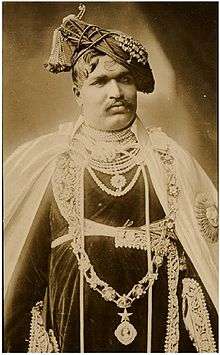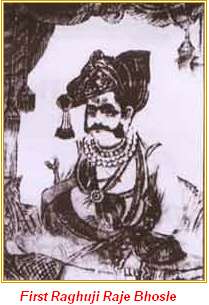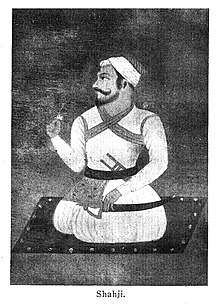Bhonsle
The Bhonsle (or Bhonsale,Bhosale, Bhosle, Bhonslà,)[1][2] are a prominent group within the Maratha clan system. Traditionally a warrior clan,[3][4] some members served as rulers of several states in India, the most prominent being Chhatrapati Shivaji, the founder of the Maratha Empire which displaced the Mughal Empire as the preeminent political and military power in India. His successors ruled as Chhatrapatis (Emperors/Maharajas) from their capital at Satara, although de facto rule of the empire passed to the Peshwas, the Maratha hereditary chief ministers, during the reign of Shahu I. In addition to the Bhonsle Chhatrapatis of Satara, rulers of the clan established themselves as junior branch of Chhatrapatis at Kolhapur, Thanjavur, and as Maharajas of Nagpur in modern-day Maharashtra in the 18th century.

| Bhonsle | |
|---|---|
| Maratha clan | |
| Ethnicity | Indian |
| Location | Maharashtra, Madhya Pradesh, Tamil Nadu |
| Language | Marathi |
After the British defeat of the Marathas in the Third Anglo-Maratha War in 1818, the four Bhonsle dynasties continued as rulers of their princely states, acknowledging British suzerainty while retaining local autonomy. The states of Satara, Thanjavur, and Nagpur came under direct British rule in the mid-nineteenth century when their rulers died without male heirs, although the British allowed titular adoptions to take place. Kolhapur state remained autonomous until India's independence in 1947, when the rulers acceded to the Indian government.
Akkalkot State,[5] Sawantwadi State[6] and Barshi[7] were amongst other prominent states ruled by the Bhonsles.
Origin
Bhonsles claim their origin from Suryavanshi Sisodia Rajputs, which is widely accepted,.[8][9][10] This genealogical tree has been presented in the city palace of Udaipur as well. Sources supporting this claim include Pandit Ganga Bhatt of Varanasi, who had been hired for the purpose by Shivaji, and in 1674 presented a genealogy tracing Shivaji's ancestry to the Sisodias of Mewar.[11]
Scholars such as Jadunath Sarkar have contested Shivaji's Rajput origin, saying that it was a fabrication required during his coronation.[12] Others, such as C. V. Vaidya, do not accept this and point to works authored before his rise that refer to the connection. For example, the Radha Madhav Vilas Champu, written by the poet Jayaram, mentions Shahaji Bhonsle, the father of Shivaji, as being a Sisodia Rajput and Shahji's letter to Sultan Adil Shah in 1641 refers to the Bhonsle as Rajputs.[13] The discovery of Persian-language firmans in the 1920s also dented the claim of those such as Sarkar. The documents bear seals and tughra of Bahmani and Adil Shahi sultans and establish the direct descent of Shivaji and Ghorpade with that of Sisodia of Chittor.[14]
The following is the Sisodia lineage which is said to have migrated from Chittor to Deccan:[15][16]
- Rana Ajay Singh of Mewar
- Rana Sujjan Singh (Sajjan Singh)
- Dilapee Singh (Dilip Singh)
- Sidhoji
- Bahiroji or Bhosaji
- Devaravji
- Ugrasen
- Shubhrakrushna
- Roopsinhji
- Bhoomindraji
- Dhapaji
- Barahatji
- Kheloji
- Parasoji
- Babaji
- Maloji Bhosle
- Shahaji
- Shivaji
- Sambhaji
- Rajaram
Some of the historical accounts stating that Shahaji and Shivaji were of Rajput descent include:
- In 1674, Pandit Ganga Bhatt of Varanasi presented a genealogy tracing Shivaji's ancestry to the Suryavanshi Kshatriya Sisodia of Mewar.[11]
- In 1726 when Maratha armies began to make incursions into the Rajput territories, Raja Chhatrapati Shahu in a letter dated 1726 ordered his generals not to touch the Sisodia territory of Pippila state in Mewar as well as the other states in Rajputana which belonged to Sisodia. He toldg them that not only did the Rawat of Piplia and the Sisodia belong to the same family as the rulers of Satara (Bhonsle), but that it was mainly due to the courage and sacrifices made by Sisodia such as Rana Hammir, Maharana Kumbha, Maharana Sanga and Maharana Pratap that Hindu rule was preserved in India.
- The Radha Madhava Vilasa Champu of the poet Jayarama (written in the court of Shahaji at Banglur, 1654) describes the Bhonsles as descendants of the Sisodias of Chittor. Jayarama's poetry was composed much before Shivaji's coronation. In a poem on Shahaji, Jayarama mentions that Shahaji was descended from Dalip (or Dilip Singh), born in the family of the Rana who was the foremost among all kings of the earth. This Dalip was a grandson of Lakshmanasen, Rana of Chittor, who came to the throne in 1303 CE.
- The Shivabharata of Paramananda mentions that Shivaji and Shahji are of the Ikshvaku lineage like the Sisodias.
- Parnalaparvata Grahanakhyana states that Shivaji is a Sisodia.
- Bhushan the Hindi poet speaks of the Bhosales being Rajput.
- Shahji in his letter to the Sultan Adilshah states he is a Rajput.[17]
- The Mughal historian Khafi Khan describes Shivaji as a descendant of the Ranas of Chittor. Khafi Khan was a very harsh critic of Shivaji, and wrote accounts condemning Shivaji to hell. He claimed that though Shivaji's ancestors did come from the family of Ranas of Chittor, they descended through an illegitimate offspring Dilip Singh.
- Sabhasad Bakhar, composed by Shivaji's minister Krishna Bhaskhar in 1694, refers to Bhonsle as a Solar Dynasty clan of Sisodia Origin.
- Persian Farmans(Grants) given to the ancestors of Ghorpade and Bhonsles by the Bahmani Sultans and Adil Shahi Sultans relate the Shivaji family of Bhonsle and that of Ghorpades directly with the Sisodia family of Udaipur.
Nobles, regents and monarchs
- Babaji Bhonsle (d. 1597), father of Maloji Bhonsle who was a patil of the Hingni Berdi and Devalgaon villages around Pune
- Maloji Bhonsle (1552–1607), father of Shahaji who served as a knight for the Ahmadnagar Sultanate
- Shahaji (1594–1664), father of Shivaji who served as a knight for the Ahmadnagar Sultanate and later the Adilshahi of Bijapur
- Shivaji (1630–1680), first Chhatrapati of the Maratha realm
- Sambhaji (1657–1689), son of Shivaji and his successor as Chhatrapati
- Rajaram Chhatrapati (1670–1700), second son of Shivaji; succeeded Sambhaji as Chhatrapati
- Tarabai (1675–1761), commander of Maratha forces after the death of her husband Rajaram in 1700; regent for her son Shivaji II until being deposed by Shahu I and then by her husband's other widow, Rajasbai.
Other maharajas of the dynasty include:
House of Satara
- Shahu I (1708–1749), son of Sambhaji, became Chhatrapati in 1708 after defeating his aunt Tarabai in a war of succession.
- Ramaraja (1749–1777), grandson of Rajaram and Tarabai; adopted son of Shahu I.
- Shahu II of Satara (1777–1808), son of Ramaraja.
- Pratap Singh.
- Chatrapati Shahaji (Abasaheb) of Satara
- Venkatji or Vyankoji Raje bhosale (bhausaheb)
- Chatrapati Ramraja 3 (Abasaheb)
- Shahu III of Satara
- PratapsinhRaje of Satara
- Udayanraje (1978–present)
House of Kolhapur

- Shivaji II of Maratha Realm, later Shivaji I of Kolhapur (1700–1714); imbecile son of Rajaram and Tarabai
- Sambhaji II (1714–1760): His mother, Rajasbai, the second wife of Rajaram, deposed Tarabai's son Shivaji II and put her own son on the Kolhapur throne.
- Shivaji III (1760–1812) (adopted from the family of Khanwilkar)
- Shahaji I (1822–1838)
- Shivaji IV (1830–1866)
- Rajaram I (1866–1870) (adopted from the family of Patankar)
- Shivaji V (1870–1883)
- Shahu I (1874–1922) (adopted from the family of Ghatge of Kagal)
- Rajaram II (1922–1940)
- Shivaji V (1940–1946)
- Shahaji II (1946–1983) (adopted from Puar dynasty of Dewas Senior)
- Shahu II (1995–present) (adopted from Bhonsle Nagpur)
House of Thanjavur, Tamil Nadu
- Shahaji Raje (1594–1664)
- Ekoji I (1676–1684) half-brother of Shivaji
- Shahuji I of Thanjavur
- Serfoji I
- Tukkoji
- Ekoji II
- Sujanbai
- Shahuji II of Thanjavur
- Pratapsingh of Thanjavur
- Thuljaji became vassal of the East India Company
- Serfoji II (1798–1832)
- Shivaji of Thanjavur (1832–1855). After his death, the state was absorbed by the East India Company.
House of Nagpur

- Raghoji I (1738–1755)
- Janoji (1755–1772)
- Mudhoji I (1772–1788)
- Raghoji II (1788–1816)
- Mudhoji II (1816–1818)
- Raghoji III (1818–1853)[18]
References
- http://books.google.co.in/books?id=51caAAAAYAAJ&q=bhonsla&dq=bhonsla&hl=en&sa=X&ei=afwfU_fPHYf_rAfvy4DYBQ&ved=0CCsQ6AEwAA
- Kulkarni, Prashant P. (6 June 1990). "Coinage of the Bhonsla Rajas of Nagpur". Indian Coin Society. Retrieved 6 June 2019 – via Google Books.
- History, Kenneth Pletcher Senior Editor, Geography and (15 August 2010). "The History of India". The Rosen Publishing Group, Inc. Retrieved 6 June 2019 – via Google Books.
- Hoiberg, Dale; Ramchandani, Indu (6 June 2000). Students' Britannica India: D to H (Dadra and Nagar Haveli to Hyena). Encyclopaedia Britannica (India). Retrieved 6 June 2019 – via Internet Archive.
bhonsle warrior clan.
- Kulkarni, Sumitra (6 June 1995). "The Satara Raj, 1818-1848: A Study in History, Administration, and Culture". Mittal Publications. Retrieved 6 June 2019 – via Google Books.
- "Portuguese Studies Review". International Conference Group on Portugal. 6 June 2001. Retrieved 6 June 2019 – via Google Books.
- "The Gazetteers Department - AKOLA". akola.nic.in.
- The Quarterly Journal of the Mythic Society (Bangalore). 1975. p. 18.
- Singh K S (1998). India's communities. Oxford University Press. p. 2211. ISBN 978-0-19-563354-2.
- Maharashtra (India) (1967). Maharashtra State Gazeteers: Maratha period. Directorate of Government Printing, Stationary and Publications, Maharashtra State. p. 147.
- Busch, Allison (2011). Poetry of Kings: The Classical Hindi Literature of Mughal India. Oxford University Press. p. 191. ISBN 978-0-19-976592-8.
- Bhalchandra Krishna Apte (1974). Chhatrapati Shivaji: coronation tercentenary commemoration volume. University of Bombay. p. 77.
- Shiri Ram Bakshi (1998). Sharad Pawar, the Maratha legacy. APH Publishing. pp. 25–. ISBN 978-81-7648-007-9. Retrieved 15 May 2011.
- Bhatia, H. S. (2001). Mahrattas, Sikhs and Southern Sultans of India: Their Fight Against Foreign Power (2nd ed.). Deep & Deep. ISBN 9788171003693. Retrieved 31 August 2012.
- Har Bilas Sarda (Diwan Bahadur),Speeches and writings
- Chintaman Vinayak Vaidya History of mediæval Hindu India: (being a history of India from 600 to 1200)
- The Marathas 1600-1818, Part 2, Volume 4 By Stewart Gordon. Page 88.
- Gadre, Prabhakar (1994). Bhosle of Nagpur and East India Company. Jaipur, India: Publication Scheme. p. 256. ISBN 81-85263-65-5.
The morning of 11th December 1853, his symptoms became more alarming and he died at 6 O'Clock.


